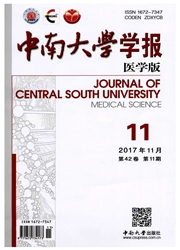

 中文摘要:
中文摘要:
目的:通过上调和沉默1-磷酸鞘氨醇2型受体(S1P2)的表达,探讨其对体外培养的脐静脉内皮细胞的功能影响。方法:采用转染外源S1P2受体质粒上调年轻脐静脉内皮细胞S1P2受体表达;应用RT-PCR和Western印迹检测空白对照组、空载体组和过表达组细胞的S1P2受体表达;同时采用Matrigel胶种植法,观察3组脐静脉内皮细胞的体外管状样结构生成能力;划痕实验分析内皮细胞的损伤愈合能力;迁移实验分析内皮细胞的化学趋化能力。以及通过RNA干扰沉默衰老脐静脉内皮细胞S1P2受体的表达,观察细胞的功能改变。结果:上调年轻脐静脉内皮细胞S1P2受体表达后,过表达组内皮细胞的成管能力、损伤愈合能力和细胞迁移率均明显低于空白对照组和空载体组(P〈0.05)。RNA干扰沉默衰老脐静脉内皮细胞S1P2受体后,干扰组内皮细胞的管状样结构生成能力、损伤愈合能力和趋化能力均明显恢复,显著高于衰老内皮细胞组和干扰对照组(P〈0.05)。结论:S1P2受体调控体外衰老内皮细胞的趋化、形态发生和损伤愈合反应的功能变化。
 英文摘要:
英文摘要:
Objective: To investigate the variation of senescent endothelial function by regulating the sphingosine-1-phosphate receptor type 2(S1P2) expression in cultured human umbilical vein endothelial cells(HUVECs).Methods: The S1P2 receptor expression was regulated by transfecting the cDNA or shRNA of S1P2 in cultured HUVECs.The expression levels of S1P2 receptor in HUVECs were detected by RT-PCR and Western blot.EC chemotaxis was measured by the transwell migration assay.The wound healing assay was performed by a scratch wound model on EC monolayer.Matrigel morphogenesis assay was employed to assess the in vitro angiogenic responses.Results: After up-regulating the S1P2 expression in young ECs,the S1P-stimulated formation of a tubular-like network in Matrigel was dramatically diminished in transfected ECs(P﹤0.05).Quantification of the wound healing assay showed that transfected ECs grew much slower than young ECs(P﹤0.05).The chemotactic capability was significantly decreased in transfected ECs(P﹤0.05).Furthermore,the senescent-associated impairments were revoked by the downregulation of S1P2 receptor in senescent HUVECs.Conclusion: The impaired functions(chemotactic,wound-healing and morphogenetic responses) in senescent HUVECs in vitro are mediated by S1P2 receptor.
 同期刊论文项目
同期刊论文项目
 同项目期刊论文
同项目期刊论文
 期刊信息
期刊信息
